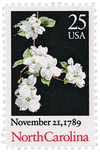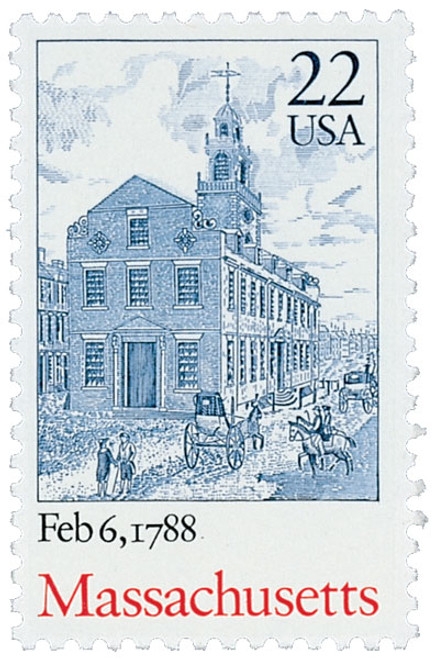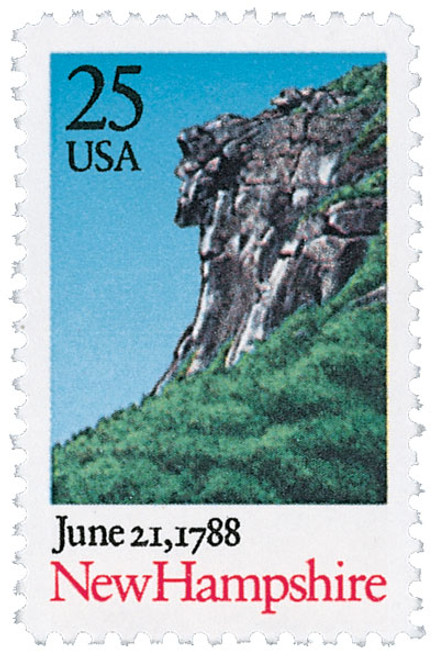
# 2347 - 1989 25c Bicentenary Statehood: North Carolina
U.S. #2347
1989 25¢ North Carolina
Bicentenary Statehood
- 12th stamp in Bicentenary Statehood Series
- Pictures the state flower, the dogwood
- First in the series not issued in the state capital
Stamp Category: Commemorative
Series: Bicentenary Statehood
Value: 25¢, first-class rate
First Day of Issue: August 22, 1989
First Day City: Fayetteville, North Carolina
Quantity Issued: 179,800,000
Printed by: American Bank Note Company
Printing Method: Lithographed, engraved, & photogravure
Format: Panes of 50 in sheets of 200
Perforations: 11
Why the stamp was issued: As part of a series honoring the 200th statehood anniversaries of the first 13 US states.
About the stamp design: Bob Timberlake, who had also designed the South Carolina Bicentennial stamp, created the artwork for this stamp. It pictures a branch of dogwood, the state flower. All or part of nine flowers can been seen on the stamp against the black background. The dogwood had previously been included on the North Carolina State Bird and Flower stamp of 1982 (US #1985).
First Day City: The First Day ceremony for this stamp was held at the First Presbyterian Church in Fayetteville, North Carolina. It was originally to be held in the capital, Raleigh, as all the other stamps in the series. But the governor requested the ceremony be moved to Fayetteville, where the ratification had occurred. The stamp was also issued three months before the actual statehood date in November as the USPS prefers to not issue new non-holiday stamps that time of year.
About the Bicentenary Statehood Series: The 1935 Michigan Centenary stamp is often considered America’s first statehood stamp. However, that stamp actually used the wrong date – Michigan ratified its constitution in 1837, but wasn’t granted statehood until 1837. The first correct statehood stamp marked the 100th anniversary of Arkansas in 1936. In the years since, many other statehood stamps were issued. However, among all these statehood stamps, 13 were missing – the first 13 states that formed our nation. With this series, the USPS planned to honor those state as they deserved.
From 1987-1990, the Bicentenary Statehood Series commemorated the signing of the Constitution by representatives of the first 13 Colonies. The stamps were issued in the 200th year after each state approved the Constitution. They were issued in the order each colony became a state, though not always on the exact date of ratification. Each stamp shows traditional symbols or scenes from the state.
History the stamp represents: On November 21, 1789, North Carolina was admitted as the 12th state of the union.
Historians believe about 35,000 Indians lived in the North Carolina region when the first Europeans arrived. Early explorers in the area included Giovanni da Verrazano, Lucas Vásquez de Ayllón, and Hernando de Soto.
In 1585, England’s Sir Walter Raleigh established a colony at Roanoke Island – the first English colony in America. These settlers were forced to return to England in 1586. Raleigh attempted settlement of Roanoke Island again in 1587, with John White as its governor. On August 18, 1587, White’s daughter gave birth to the first English child born in America, Virginia Dare.
White sailed back to England for supplies that year. War delayed White from returning until 1590 when he discovered the colony had disappeared. The only clue the colonists left were the letters “cro” and the word “croatoan” carved into a tree. Croatoan was one of the names of a friendly Indian group in the area. The fate of the over 100 men, women, and children of that colony remains a mystery to this day.
Other attempts to settle the Carolina (land of Charles) region failed as well. The first successful European settlers came from Virginia. They settled in the Albemarle Sound area around 1650. In 1663, England’s King Charles II divided Carolina (which included present-day North and South Carolina and extended to the Pacific) between eight lords’ proprietors. The land was divided into three counties: Albemarle in the north, Clarendon in the Cape Fear region, and Craven in what is now South Carolina.
In 1677, some of the colonists in Albemarle, the only county with a government at that time, revolted against their governor. This revolt was named Culpeper’s Rebellion, after one of its leaders, John Culpeper. The Albemarle colonists removed five governors between 1664 and 1689. This led to a reorganization of the colony. North Carolina became a separate colony in 1712.
The North Carolina colonists endured many hardships. In 1710, Swiss and German colonists crossed the Neuse River and established a settlement on Tuscarora Indian land. On September 22, 1711, the Tuscarora launched an attack destroying most of the settlements between the Neuse and Pamlico Rivers. Hundreds of settlers were killed. The Tuscarora War ended on March 25, 1713, with a victory for the colonists. Blackbeard and other pirates terrorized the North Carolina coast. Most piracy ended in 1718 when Blackbeard was killed in a battle. In 1760, North Carolina troops defeated the Cherokee Indians at Fort Dobbs. The Cherokee signed a treaty in 1761, opening vast amounts of land in Virginia and the Carolinas to settlement.
The colonists of North Carolina were especially opposed to Britain’s policy of taxation without representation. Members of the Sons of Liberty led demonstrations and even took up arms in opposition to the taxes. In the west, farmers opposed taxes imposed by the colony’s more established and wealthy planters. The western rebels, known as Regulators, were not defeated until more than a thousand troops were sent to fight them at the Battle of Alamance on May 16, 1771.
When the Revolutionary War started in Massachusetts in April 1775, North Carolina’s citizens were divided over the conflict. Those who opposed British rule were called Whigs, those who supported the British were Tories. Violent confrontations between the groups resulted in a great deal of bitterness. On February 27, 1776, Whig forces defeated the Tories at the Battle of Moore’s Creek Bridge. This marked the first battle of the Revolutionary War in North Carolina. On April 12, 1776, North Carolina became the first colony to vote for independence in the Continental Congress. Soon after, it adopted its first constitution.
North Carolina opposed a strong federal government and refused to ratify the Constitution until the Bill of Rights was added. On November 21, 1789, North Carolina became the 12th state to join the Union. The state was one of the least developed, with little industry, until 1835, when it revised its constitution. Schools, railroads, and roads were built. Both agricultural and manufacturing output increased greatly. North Carolina was the nation’s leading gold producer until the California Gold Rush of 1849.
Although a Southern state, North Carolina attempted to preserve the Union. It was not until after President Lincoln called for troops that the state seceded, on May 20, 1861. More than 10 Civil War battles were fought there. In fact, about 25% of all the Confederate soldiers killed in the war came from North Carolina. According to tradition, some Confederate troops retreated during the heat of a battle, leaving only soldiers from North Carolina to fight. The North Carolinians said they should put tar on the heels of the other soldiers so they would “stick better in the next fight.”
The state’s black citizens were severely repressed after the war. In 1898, the state’s constitution deprived most blacks of the right to vote. Laws required racial segregation in most of public life. During the mid-1900s, blacks began gaining greater rights. In 1954, the Supreme Court ruled school segregation illegal. Sit-in demonstrations protested segregation in other public areas. The Civil Rights Act of 1964 finally banned segregation of public facilities.
North Carolina’s economy has grown steadily as both manufacturing and agricultural output has increased. The state leads the nation in the farming and production of tobacco products, as well as the production of textiles and wooden furniture. In 1959, three universities – Duke University, North Carolina State University, and the University of North Carolina – combined their resources to open the North Carolina Research Triangle Park. This research center serves industry and has brought great prosperity to Durham, Raleigh, Chapel Hill, and the surrounding areas.
U.S. #2347
1989 25¢ North Carolina
Bicentenary Statehood
- 12th stamp in Bicentenary Statehood Series
- Pictures the state flower, the dogwood
- First in the series not issued in the state capital
Stamp Category: Commemorative
Series: Bicentenary Statehood
Value: 25¢, first-class rate
First Day of Issue: August 22, 1989
First Day City: Fayetteville, North Carolina
Quantity Issued: 179,800,000
Printed by: American Bank Note Company
Printing Method: Lithographed, engraved, & photogravure
Format: Panes of 50 in sheets of 200
Perforations: 11
Why the stamp was issued: As part of a series honoring the 200th statehood anniversaries of the first 13 US states.
About the stamp design: Bob Timberlake, who had also designed the South Carolina Bicentennial stamp, created the artwork for this stamp. It pictures a branch of dogwood, the state flower. All or part of nine flowers can been seen on the stamp against the black background. The dogwood had previously been included on the North Carolina State Bird and Flower stamp of 1982 (US #1985).
First Day City: The First Day ceremony for this stamp was held at the First Presbyterian Church in Fayetteville, North Carolina. It was originally to be held in the capital, Raleigh, as all the other stamps in the series. But the governor requested the ceremony be moved to Fayetteville, where the ratification had occurred. The stamp was also issued three months before the actual statehood date in November as the USPS prefers to not issue new non-holiday stamps that time of year.
About the Bicentenary Statehood Series: The 1935 Michigan Centenary stamp is often considered America’s first statehood stamp. However, that stamp actually used the wrong date – Michigan ratified its constitution in 1837, but wasn’t granted statehood until 1837. The first correct statehood stamp marked the 100th anniversary of Arkansas in 1936. In the years since, many other statehood stamps were issued. However, among all these statehood stamps, 13 were missing – the first 13 states that formed our nation. With this series, the USPS planned to honor those state as they deserved.
From 1987-1990, the Bicentenary Statehood Series commemorated the signing of the Constitution by representatives of the first 13 Colonies. The stamps were issued in the 200th year after each state approved the Constitution. They were issued in the order each colony became a state, though not always on the exact date of ratification. Each stamp shows traditional symbols or scenes from the state.
History the stamp represents: On November 21, 1789, North Carolina was admitted as the 12th state of the union.
Historians believe about 35,000 Indians lived in the North Carolina region when the first Europeans arrived. Early explorers in the area included Giovanni da Verrazano, Lucas Vásquez de Ayllón, and Hernando de Soto.
In 1585, England’s Sir Walter Raleigh established a colony at Roanoke Island – the first English colony in America. These settlers were forced to return to England in 1586. Raleigh attempted settlement of Roanoke Island again in 1587, with John White as its governor. On August 18, 1587, White’s daughter gave birth to the first English child born in America, Virginia Dare.
White sailed back to England for supplies that year. War delayed White from returning until 1590 when he discovered the colony had disappeared. The only clue the colonists left were the letters “cro” and the word “croatoan” carved into a tree. Croatoan was one of the names of a friendly Indian group in the area. The fate of the over 100 men, women, and children of that colony remains a mystery to this day.
Other attempts to settle the Carolina (land of Charles) region failed as well. The first successful European settlers came from Virginia. They settled in the Albemarle Sound area around 1650. In 1663, England’s King Charles II divided Carolina (which included present-day North and South Carolina and extended to the Pacific) between eight lords’ proprietors. The land was divided into three counties: Albemarle in the north, Clarendon in the Cape Fear region, and Craven in what is now South Carolina.
In 1677, some of the colonists in Albemarle, the only county with a government at that time, revolted against their governor. This revolt was named Culpeper’s Rebellion, after one of its leaders, John Culpeper. The Albemarle colonists removed five governors between 1664 and 1689. This led to a reorganization of the colony. North Carolina became a separate colony in 1712.
The North Carolina colonists endured many hardships. In 1710, Swiss and German colonists crossed the Neuse River and established a settlement on Tuscarora Indian land. On September 22, 1711, the Tuscarora launched an attack destroying most of the settlements between the Neuse and Pamlico Rivers. Hundreds of settlers were killed. The Tuscarora War ended on March 25, 1713, with a victory for the colonists. Blackbeard and other pirates terrorized the North Carolina coast. Most piracy ended in 1718 when Blackbeard was killed in a battle. In 1760, North Carolina troops defeated the Cherokee Indians at Fort Dobbs. The Cherokee signed a treaty in 1761, opening vast amounts of land in Virginia and the Carolinas to settlement.
The colonists of North Carolina were especially opposed to Britain’s policy of taxation without representation. Members of the Sons of Liberty led demonstrations and even took up arms in opposition to the taxes. In the west, farmers opposed taxes imposed by the colony’s more established and wealthy planters. The western rebels, known as Regulators, were not defeated until more than a thousand troops were sent to fight them at the Battle of Alamance on May 16, 1771.
When the Revolutionary War started in Massachusetts in April 1775, North Carolina’s citizens were divided over the conflict. Those who opposed British rule were called Whigs, those who supported the British were Tories. Violent confrontations between the groups resulted in a great deal of bitterness. On February 27, 1776, Whig forces defeated the Tories at the Battle of Moore’s Creek Bridge. This marked the first battle of the Revolutionary War in North Carolina. On April 12, 1776, North Carolina became the first colony to vote for independence in the Continental Congress. Soon after, it adopted its first constitution.
North Carolina opposed a strong federal government and refused to ratify the Constitution until the Bill of Rights was added. On November 21, 1789, North Carolina became the 12th state to join the Union. The state was one of the least developed, with little industry, until 1835, when it revised its constitution. Schools, railroads, and roads were built. Both agricultural and manufacturing output increased greatly. North Carolina was the nation’s leading gold producer until the California Gold Rush of 1849.
Although a Southern state, North Carolina attempted to preserve the Union. It was not until after President Lincoln called for troops that the state seceded, on May 20, 1861. More than 10 Civil War battles were fought there. In fact, about 25% of all the Confederate soldiers killed in the war came from North Carolina. According to tradition, some Confederate troops retreated during the heat of a battle, leaving only soldiers from North Carolina to fight. The North Carolinians said they should put tar on the heels of the other soldiers so they would “stick better in the next fight.”
The state’s black citizens were severely repressed after the war. In 1898, the state’s constitution deprived most blacks of the right to vote. Laws required racial segregation in most of public life. During the mid-1900s, blacks began gaining greater rights. In 1954, the Supreme Court ruled school segregation illegal. Sit-in demonstrations protested segregation in other public areas. The Civil Rights Act of 1964 finally banned segregation of public facilities.
North Carolina’s economy has grown steadily as both manufacturing and agricultural output has increased. The state leads the nation in the farming and production of tobacco products, as well as the production of textiles and wooden furniture. In 1959, three universities – Duke University, North Carolina State University, and the University of North Carolina – combined their resources to open the North Carolina Research Triangle Park. This research center serves industry and has brought great prosperity to Durham, Raleigh, Chapel Hill, and the surrounding areas.





















